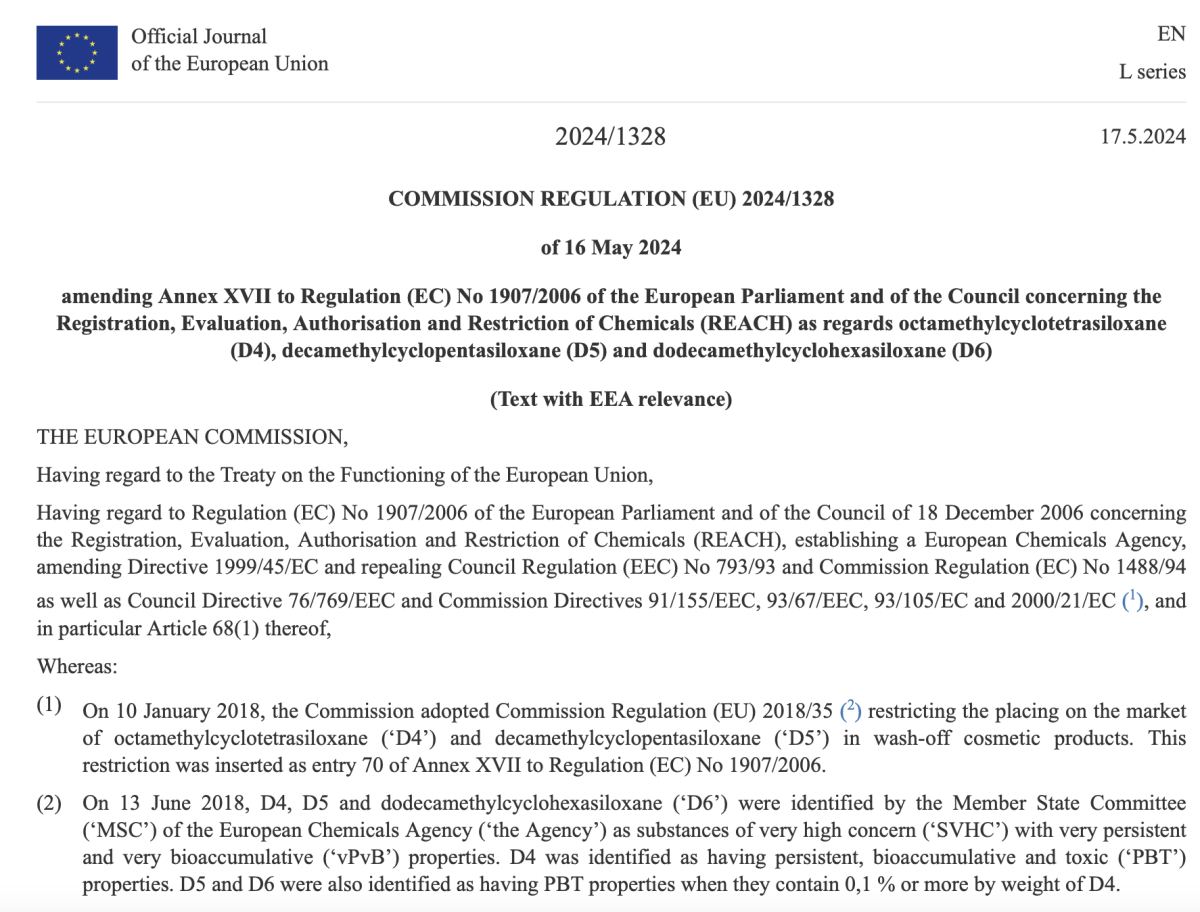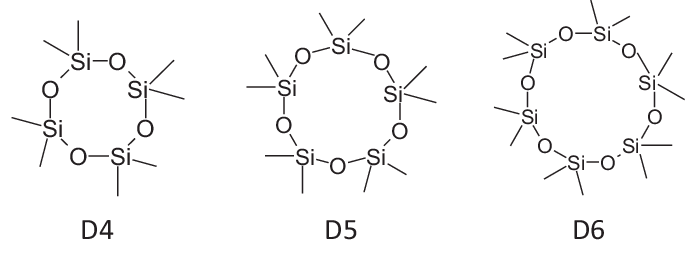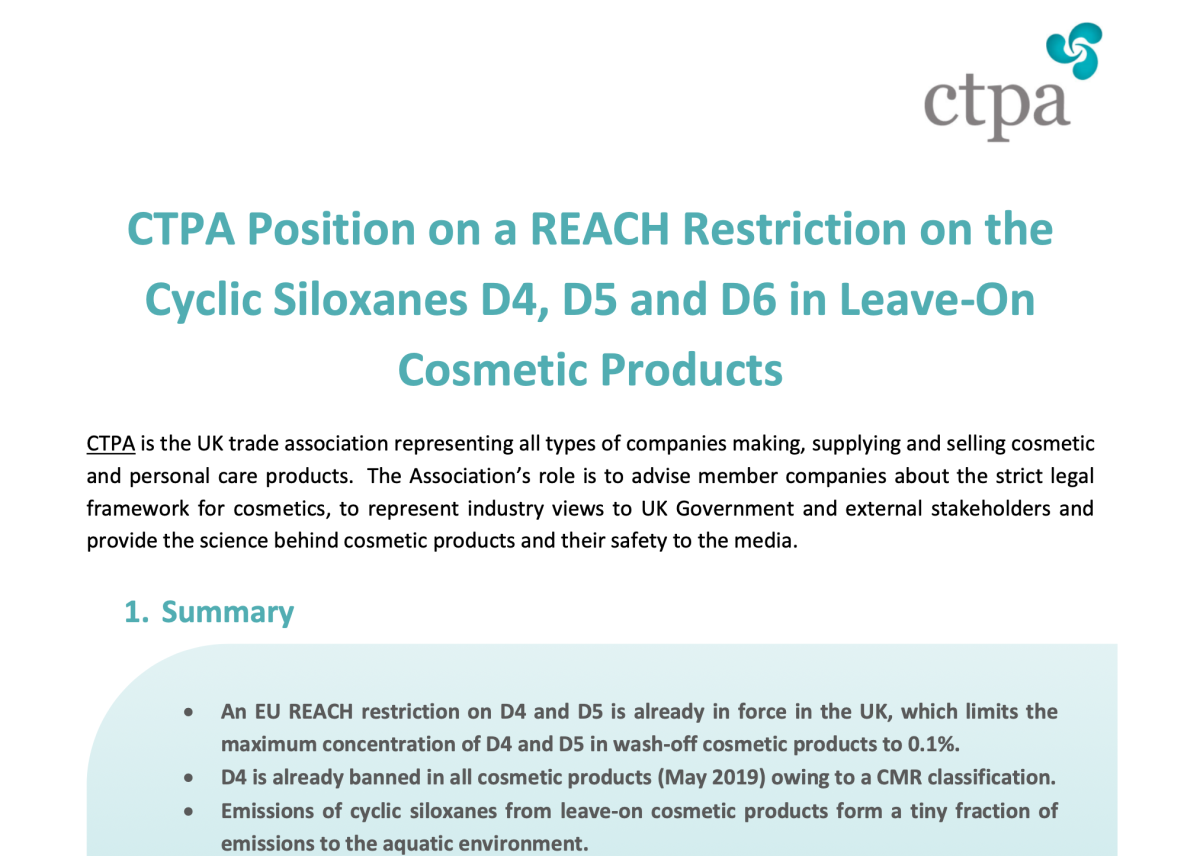According to the Official Journal of the European Union (EU), on May 16, the European Parliament amended the Registration, Evaluation, Authorization and Restriction of Chemicals (REACH) regulation to further restrict the use of cyclic silicones in cosmetics.

The new restriction adds to the existing restrictions on D4 and D5 in the REACH regulation, and effective June 6, 2026, decamethylcyclopentasiloxane (D5) and dodecamethylcyclohexasiloxane (D6) may not be used in rinse-off and leave-on cosmetic products at a maximum concentration of more than 0.1 percent. The restriction on D5 in rinse-off products will be effective from January 31, 2020 onwards. In addition, octamethylcyclotetrasiloxane (D4) has been banned under Annex II of the EU Cosmetics Regulation.
What are D4, D5 and D6?
Octamethylcyclotetrasiloxane (D4), decamethylcyclopentasiloxane (D5), and dodecamethylcyclohexasiloxane (D6) are cyclic volatile methylsiloxane (cVMS) substances with 4, 5, and 6 siloxane groups, respectively.

D4 is a low volatile liquid with excellent water and oil resistance. In cosmetics, D4 is often used as an ingredient in hair care products, such as conditioners and hair masks, to provide slip and reduce hair damage. However, due to its environmental impact and potential ecotoxicity, some countries and regions have begun to restrict or reduce the use of D4 in cosmetics.
D5 is a commonly used silicone-based oil substance that is widely used in cosmetics for its excellent lubricity and ease of application. Not only does it give products such as moisturizers and make-up bases an excellent slip, but it also helps to form a protective layer that reduces moisture loss. In addition, D5 is used in hair shine and anti-frizz products to provide long-lasting shine and smoothness.
D6 is similar to D4 and D5, but has a larger molecular structure, making it less volatile and suitable for use as a moisturizing ingredient in skin and hair care products. It helps to enhance the softness of skin and hair while providing long-lasting moisturization.
D4, D5, D6 These silicone compounds are widely used in cosmetics mainly because they provide a very favorable sensory experience, improve the texture and feel of the product, and help form a protective layer. However, these materials are also highly persistent and bioaccumulative (vPvB), and stricter regulation of the use of these compounds has begun in some regions, having been identified as Substances of Very High Concern (SVHC) by the EU in 2018.
Persistence, bioaccumulation and toxicity issues
The European Chemicals Agency (ECHA) believes that the new regulation is a step in the right direction. In fact, ECHA had initially proposed this restriction in January 2019, which was supported by an opinion issued in 2020 by the Scientific Committee on Risk Assessment and Socio-Economic Analysis.
Based on ECHA’s recommendation:
– Decamethylcyclopentasiloxane (D5) meets the criteria of Article 57(d) of Regulation (EC) 1907/2006 (REACH), i.e. it is persistent, bioaccumulative and toxic when contained in ≥ 0.1 % w/w of octamethylcyclotetrasiloxane (D4) (EC No. 209-136-7); and
– When dodecamethylcyclohexasiloxane (D6) contains ≥ 0.1 % w/w octamethylcyclotetrasiloxane (D4) (EC No. 209-136-7), it meets the criteria of Article 57 (d) of the (EC) 1907/2006 (REACH) Regulation, i.e. the substance is persistent, bioaccumulative and toxic. In addition to its intrinsic properties, when it contains ≥ 0.1 % w/w decamethylcyclopentasiloxane (D5) (EC No. 208-764-9) or ≥ 0.1 % w/w octamethylcyclotetrasiloxane (D4) (EC No. 209-136-7), it fulfills the criteria of Article 57 (e) of Regulation (EC) 1907/2006 (REACH) regarding persistence and bioaccumulation. (EC No. 2091367), it also fulfills the criteria of Article 57 (e) of the Regulation (EC 1907/2006 (REACH)) on persistent and very bioaccumulative (vPvB) substances.
ECHA responded to the news of the amendment in a newsletter, “This measure will protect our environment by reducing the release of these very persistent and very bioaccumulative substances by up to 90%”.
How will it affect the cosmetics industry?
The new restrictions are likely to cause problems for a number of cosmetic formulators.
In a statement, the Cosmetic Toiletry & Perfumery Association (CTPA) in the UK said, “D5 and D6 are very important ingredients in a wide range of cosmetic products with unique properties that cannot be fully replicated by alternative ingredients. Substituting these ingredients reduces product performance and, in some cases, product usability, with no benefit to the environment.”
Other experts believe that a ban on cyclic silicones will have a huge impact on the color cosmetics sector, where these materials are critical to the beauty and performance of makeup. “There is no 1:1 alternative to cyclic silicones.” Cyclic silicones are not only a single ingredient in formulations, but also a solvent or carrier for many other ingredients, so the upcoming ban will affect many ingredient choices. Not only will formulators already using cyclic silicones have to choose alternative solvents as carriers in their formulations, but even suppliers of many of the emulsifiers, film-formers, texturizers and thickeners sold as cyclic silicone dispersions or solutions will have to find suitable alternatives.
CTPA UK also says that current restrictions imposed on these materials have reduced rinse-off products in wastewater and aquatic environments and reduced volatile emissions from leave-on products. “The results of the study show that emissions to wastewater from leave-on cosmetics are significantly lower than from rinse-off products because D5 evaporates from the product during its residence on the skin or hair. Therefore, the published limits on D4 and D5 in rinse-off products are the most appropriate risk management measures.”

Canada’s Financial Post predicts that if the European Union bans the use of these key silicone ingredients, “economic chaos” will ensue, with concerns that the impact will extend beyond cosmetics to broader markets. “Without these silicones, it would be difficult to produce semiconductors, and a massive shortage of semiconductors would mean higher prices and poorer quality for consumers. That doesn’t include the commodity markets that use these chips as inputs – everything from automobiles to computers to consumer electronics,” he added. The total cost of the impact is so large and complex that it is difficult to estimate …… If the substances are indeed so harmful that they deserve to be listed, then even the economic disruption is worth it. But the European Union is the only entity in the world that lists these substances as POPs and restricts the use of siloxanes in commerce. The Canadian government investigated them and came to a different conclusion.”
North American regulators take a different view
How the U.S. Environmental Protection Agency (EPA) and Health Canada came to conclusions about the environmental and toxicological properties of cyclic silicones contrary to the EU.
The U.S. EPA concluded that decamethylcyclopentasiloxane does not bioaccumulate due to evaporation from the skin and exhalation and does not pose an environmental hazard.
The Health Canada report, on the other hand, concluded that due to the volatility of cyclosilicones, they are vented into the atmosphere, where they undergo degradation, first to silanols and then to carbon dioxide, water and silica. Therefore, these products do not pose an environmental hazard.
In addition, the amount of volatilization and degradation in the atmosphere is equal to the amount of new emissions, as evidenced by the constant amount measured in the environment, and therefore Health Canada considers this material to be persistent but not cumulative. The material is therefore not considered to be harmful to human health or the environment.
According to some experts at CTPA UK, “Cosmetic regulations in the EU and UK are risk-based and cosmetics and their ingredients are subject to rigorous risk assessments to ensure they are safe for use. For example, the proposed action against microplastics and the CSS (EU Strategy for the Sustainable Development of Chemicals) are both hazard-driven. This is a worrying trend, which will affect the industry as a whole and ultimately consumers in the future. While it is necessary to maintain a robust, long-term process to manage the chemicals we use in our everyday products, it is important that such a strategy is rooted in in-depth scientific knowledge and an assessment of the main risks that need to be addressed.”
How should the cosmetics industry respond?
For cosmetic manufacturers or brand owners, products need to be tested for the presence of D5 or D6 and compliance with the 0.1% concentration limit, or otherwise reformulated, retested and recommunicated to the CPNP. It is also important to ensure that by June 6, 2027, non-compliant products are removed from the EU market, and good supply chain management is essential.
It is to be expected that the replacement of cyclic silicones will be the focus of much formulation and related cosmetic R&D in the short to long term.
D5 and D6 are used in a variety of different leave-on cosmetics, especially in the skin care, leave-on hair care and deodorant categories. Replacing D5 and D6 in different types of personal care products needs to be addressed on a case-by-case basis and requires a major formulation renewal effort with new formulation approaches and the creation of new product structures to achieve product compatibility with the desired performance characteristics and organoleptic benefits of the specific original silicone-containing finished product.
Some domestic organizations have commented that, overall, the impact of this restriction on D4, D5 and D6 on the domestic silicone industry is relatively small, and companies can meet most of the restrictions by considering residual D4, D5 and D6 issues.

